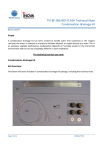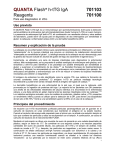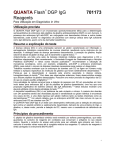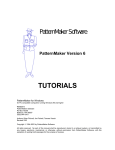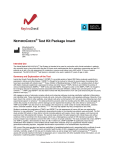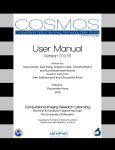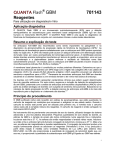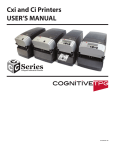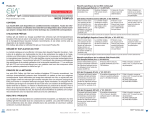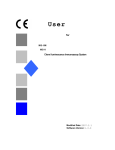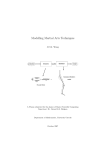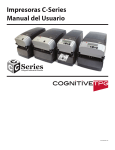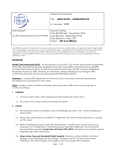Download QUANTA Flash h-tTG IgA 701103
Transcript
Format to CLSI Standards GP2-A5 (Formerly NCCLS) Vol. 26 No. 12 Issue Date: 08/16/2012 QUANTA FlashTM h-tTG IgA 701103 For In Vitro Diagnostic Use Principles of the Procedure Recombinant h-tTG is coated on to paramagnetic latex beads, which are stored in the reagent cartridge under conditions that preserve the antigen in its reactive state. When the assay cartridge is ready to be used for the first time, a buffer solution is added to the tube containing the preserved beads, and the beads are mixed with the buffer. ® The reagent cartridge is then loaded onto the BIO-FLASH instrument. A patient serum sample is prediluted by the instrument using sample buffer added to a disposable plastic cuvette. Small amounts of the diluted patient serum, the h-tTG beads, and the assay buffer are all combined into a second cuvette, and mixed. This cuvette is incubated at 37°C. The beads are then magnetized and washed several times. Isoluminol conjugated antibody is then added to the cuvette, and incubated at 37°C. Again, the beads are magnetized and washed repeatedly. The isoluminol conjugate produces a luminescent reaction when reagents (“Triggers”) are added to the cuvette. The light produced from this reaction is measured as Relative Light Units (RLU) by the BIO-FLASH optical system. The RLU are proportional to the amount of bound isoluminol conjugate, which in turn is proportional to the amount of IgA anti-h-tTG antibodies bound to the h-tTG on the beads. The QUANTA Flash h-tTG IgA assay utilizes a predefined lot specific Master Curve that is uploaded into the instrument through the reagent cartridge barcode. Based on the results of running two calibrators, an instrument specific Working Curve is created, which is used to calculate chemiluminescent units (CU) from the RLU obtained for each patient. The QUANTA Flash h-tTG IgA is a chemiluminescent immunoassay (CIA) for the semi-quantitative detection of IgA anti-human tissue transglutaminase (h-tTG) antibodies in human serum. The presence of IgA anti-h-tTG antibodies, in conjunction with clinical findings and other laboratory tests, can aid in the diagnosis of the gluten sensitive enteropathies celiac disease (CD) and dermatitis herpetiformis (DH). Celiac disease is a chronic condition whose main features include inflammation and characteristic “flattening” of intestinal mucosa resulting in a malabsorption syndrome known as a gluten sensitive enteropathy. The exact etiology 1,2 of the disease remains unknown but gliadin, the alcohol soluble fraction of wheat gluten, is clearly the toxic agent. Originally, a series of intestinal biopsies was used to diagnose celiac disease. More recently, serological testing for anti-gliadin, anti-endomysial and anti-tTG antibodies has been suggested for screening patients with suspected 3-5 gluten sensitive enteropathy as well as for monitoring dietary compliance. The European Society of Pediatric Gastroenterology and Nutrition has recommended the use of antibody markers such as anti-gliadin and anti5 endomysial antibodies to reduce the number of intestinal biopsies needed to make a diagnosis. 6 The endomysial antigen has been identified as the protein cross-linking enzyme tTG. The h-tTG antigen has been produced by recombinant technology, and may have certain advantages compared with the antigen from guinea pig 7,8 liver. Dermatitis herpetiformis is a skin disease that, as with celiac disease, is caused by ingestion of wheat protein. A majority of patients with DH have jejunal villous atrophy identical to that found in celiac disease and strict gluten-free 1,2,9 Current serological methods such as the endomysial, native gliadin and diet improves both gut and skin lesions. 9 tTG assays exhibit lower performance when testing for DH, with sensitivities ranging from only 60-75% , compared to 3-8 sensitivities greater than 95% for celiac disease. INOVA Diagnostics, Inc. 9900 Old Grove Road San Diego, CA 92131-1638, USA Tel. +1 858 586 9900 – Fax: +1 858 586 9911 http://www.inovadx.com 701100_nccls_EN Page 1 of 12 Reagents 1. 2. QUANTA Flash h-tTG IgA reagent cartridge contains the following reagents for 50 tests: a. h-tTG coated paramagnetic beads, preserved prior to first time use. b. Assay buffer – colored pink, containing Tris-buffered saline, Tween 20, protein stabilizers and preservatives. c. Tracer IgA – Isoluminol labeled anti-human IgA antibody, containing buffer, protein stabilizers and preservative. d. Sample buffer – phosphate buffered saline with Tween 20. Resuspension buffer, 1 vial - colored pink, containing buffer, protein stabilizers and preservatives. Materials provided 1 1 1 QUANTA Flash h-tTG IgA reagent cartridge 3mL resuspension buffer Transfer pipet Additional Materials Required But Not Provided BIO-FLASH instrument with operating computer BIO-FLASH System Rinse (Part Number: 3000-8205) BIO-FLASH Triggers (Part Number: 3000-8204) BIO-FLASH Cuvettes (Part Number: 3000-8206) QUANTA Flash h-tTG IgA Calibrators (Part Number: 701101) QUANTA Flash h-tTG IgA Controls (Part Number: 701102) Specimen This procedure should be performed with a serum specimen. Microbially contaminated, heat-treated, or specimens containing visible particulates should not be used. Grossly hemolyzed or iteric serum should not be used. Following collection, the serum should be separated from the clot. CLSI Document H18-A3 recommends the following storage conditions for samples: 1) Store samples at room temperature no longer than 8 hours. 2) If the assay will not be completed within 8 hours, refrigerate the sample at 2-8°C. 3) If the assay will not be completed within 48 hours, or for shipment of the sample, freeze at -20°C or lower. Frozen specimens must be mixed well after thawing and prior to testing. Special Safety Precautions/Storage Conditions 1. 2. Store unopened reagent cartridges and resuspension buffer at 2-8°C. Do not freeze. Reagents are stable until the expiration date when stored and handled as directed. Opened reagent cartridges should be stored onboard the instrument and are stable for a total of 20 days, after which time they must be discarded. The BIO-FLASH software monitors the expiration dates of the onboard cartridges, as well as the reagent cartridge lots. Procedural Notes: Warnings 1. WARNING: The assay buffer contains a chemical (0.02% chloramphenicol) known to the State of California 2. 3. 4. to cause cancer. Sodium Azide is used as a preservative. Sodium Azide is a poison and may be toxic if ingested or absorbed through the skin or eyes. Sodium azide may react with lead or copper plumbing to form potentially explosive metal azides. Flush sinks, if used for reagent disposal, with large volumes of water to prevent azide build-up. Use appropriate personal protective equipment while working with the reagents provided. Spilled reagents should be cleaned up immediately. Observe all federal, state and local environmental regulations when disposing of wastes. Precautions SEE WARNINGS INOVA Diagnostics, Inc. 9900 Old Grove Road San Diego, CA 92131-1638, USA Tel. +1 858 586 9900 – Fax: +1 858 586 9911 http://www.inovadx.com 701100_nccls_EN Page 2 of 12 Quality Control The QUANTA Flash h-tTG IgA Controls (sold separately - INOVA Item Number 701102) contains both h-tTG IgA Positive and Negative Controls. Refer to the section titled QUANTA Flash™ h-tTG IgA Controls 701102 of this Direction Insert for detailed instructions on how to input the unit value and standard deviation of each control into the software, as well as how to run the controls. Controls are recommended to be run once every day that the assay is used. Interpretation of Results The QUANTA Flash Assay is capable of detecting small differences in patient populations. Each laboratory should establish its own normal range based upon its own controls and patient population according to their own established procedures. It is suggested that the results reported by the laboratory should include the statement: “The following results were obtained with the INOVA QUANTA Flash h-tTG IgA chemiluminescent immunoassay. Values obtained with different manufacturers’ assay methods may not be used interchangeably. The magnitude of the reported IgA autoantibody levels cannot always be correlated to an endpoint titer.” Procedure: Method Before you start Using the BIO-FLASH Chemiluminescent Analyzer 1. 2. 3. 4. 5. Refer to the user's manual provided with the BIO-FLASH system for detailed operating instructions of the BIO-FLASH chemiluminescent analyzer and the BIO-FLASH software. For additional information and for troubleshooting problems with this assay, contact INOVA Diagnostics, Inc. technical service at the address or telephone number found at the end of this Direction Insert. To empty the solid waste container, open the waste drawer. Remove the solid waste container and dispose of the solid non-hazardous waste (used cuvettes). Replace the solid waste container, close the waste drawer, and click Yes in the Empty Waste Drawer window. To replace the triggers, click the Bulks Inventory F9 button (upper right). a. In the Inventory – Bulks screen, click the Triggers button on the left. A new window will pop up titled Add Triggers – Remove old bottles. b. Open and remove the waste drawer on the BIO-FLASH instrument. Dispose of any cuvettes in the dry waste drawer. Click Yes on the Empty Waste Drawer window. Remove the trigger bottles from their holders and click the Next button. Unscrew the old trigger bottles from their caps and replace with new triggers. Be sure to do them one at a time, and match the color-coded caps (white to white and red to red). c. Follow the instructions in the new window Add Triggers – Add Trigger 2 bottle. Once the barcode has been accepted, place Trigger 2 into the color-coded white holder. Click Next. d. Follow the instructions in the window Add Triggers – Add Trigger 1 bottle. Once the barcode has been accepted, place Trigger 1 into the color-coded red holder. Click Finish. Replace and close the waste drawer. To replace the System Rinse container, click the Bulks Inventory F9 button (upper right corner). In the Inventory – Bulks screen, click the Sys. Rinse button. In the new window Add System Rinse – Remove bottles, click Next. Follow the instructions in the new window Add System Rinse – Add bottle. Once the barcode has been accepted, click Finish if necessary. To empty the Fluid Waste Container, from the Inventory – Bulks screen, click the Fluid Waste button. Remove and dispose of the fluid waste. Click Next. Once the empty bottle has been replaced, click Finish. Programming and Running Samples 1. 2. 3. 4. Press the Worklist button at the top of the screen and select the Racks tab at the bottom. Select the sample rack to be used by highlighting the rack on the screen or by scanning its barcode with the handheld barcode reader. Scan or type in the sample name, select the sample type, container type (tube/cup) and select h-tTG_IgA from the assay panel. Repeat these steps for all samples. Load the samples into the selected positions in the sample rack, and load the rack into the sample carousel of the instrument. If all required materials are onboard the instrument, the start icon will be available, in green, at the top of the screen. Press the start icon to begin the run. INOVA Diagnostics, Inc. 9900 Old Grove Road San Diego, CA 92131-1638, USA Tel. +1 858 586 9900 – Fax: +1 858 586 9911 http://www.inovadx.com 701100_nccls_EN Page 3 of 12 Reagent Cartridge Preparation The first time the reagent cartridge is to be used, the storage seals on the reagent tubes must be pierced, and the htTG coated beads must be mixed with resuspension buffer. 1. Place the reagent cartridge on a solid surface. Hold the reagent cartridge in place with one hand. With your other hand, firmly grasp the red pull-tab on the back of the reagent cartridge and pull it out completely. 2. Press the two tabs on the sides of the piercing cap (grey part) and apply pressure to the top portion of the reagent cartridge until it snaps down into a locked position. The tabs should no longer be visible. 3. Resuspend the kit reagents: a) Uncap the resuspension buffer vial and collect fluid into the transfer pipette provided. The entire contents of the vial will be used. b) Slide the door in the reagent cartridge lid to the open position by gently pressing the narrow side on the reagent cartridge, and hold it in this position. Analytically transfer the entire contents of the vial into the bead reagent tube through the one single hole on the top of the reagent cartridge. c) Mix the contents of the bead reagent tube by aspirating and dispensing the liquid at least 30 times. If visible clumps of beads are observed, continue to mix the solution for another 30 times. d) Be sure to dispense all the liquid before removing the pipette from the tube and discarding it. 4. 5. Peel the sticker off the top of the reagent cartridge to reveal the other three holes. Place the reagent cartridge into any open slot on the reagent carousel of the BIO-FLASH instrument. Assay Procedure Assay Calibration 1. 2. 3. Each new lot of reagent cartridge must be calibrated prior to first time use. The software will not allow a new lot to be used until it is calibrated. Refer to the section titled QUANTA Flash™ h-tTG IgA Calibrators 701101 of this Direction Insert for detailed instructions of how to calibrate the reagent cartridge. Once the calibration is validated, the reagent cartridge lot on which the calibration was performed is ready for use. INOVA Diagnostics, Inc. 9900 Old Grove Road San Diego, CA 92131-1638, USA Tel. +1 858 586 9900 – Fax: +1 858 586 9911 http://www.inovadx.com 701100_nccls_EN Page 4 of 12 Calculation of Results A five point Master Curve is produced at INOVA for each new lot of QUANTA Flash h-tTG IgA. This four parameter logistic curve is encoded in the barcode of each reagent cartridge. Once a reagent cartridge has been calibrated, a machine specific working curve will be used to convert the RLU to CU. The IgA antibody reactivity for h-tTG can then be classified according to the table below. Reactivity Negative Weak Positive Positive CU <20 20-30 >30 Reactivity in CU is directly related to the titer of the autoantibody in the patient sample. Increases and decreases in patient antibody concentrations will be reflected in a corresponding rise or fall in CU, which is proportional to the amount of antibody. The reportable range of the assay is 1.9 CU to 4965.5 CU. If a patient result is less than 1.9 CU, then the BIO-FLASH system will report it as “<1.9 CU”. Since this is less than 20 CU, it is considered a negative result. If a patient result is greater than 4965.5 CU, then the BIO-FLASH system will report it as “>4965.5 CU”. This is considered a positive result. The BIO-FLASH software has an Auto-Rerun option available. If this option is selected, the instrument will automatically rerun any sample that has a result >4965.5 CU by further diluting it by a factor of 10, and calculate the actual CU using this additional dilution factor. Expected Values & Specific Performance Characteristics The assay cutoff was determined by testing 446 clinically characterized samples—single bleeds of patients who were clearly diagnosed with or without celiac disease (and were not on a gluten-free diet). These samples—117 clinically positive and 329 clinically negative—were used to adjust the cutoff to 20 CU to optimize sensitivity and specificity at 92.3% and 98.2%, respectively, in this training set. Method Comparison with Predicate Device Samples for method comparison analysis included those samples from the clinical validation studies (CD, non-CD and dermatitis herpetiformis patients) that were within the reportable range of the assay. These samples were tested on both the QUANTA Flash IgA h-tTG and on the predicate ELISA. Method Comparison (N = 140) h-tTG IgA ELISA Percent Agreement (95% confidence) Positive Negative Total Positive 69 2* 71 Pos. Agree = 100% (94.7-100%) QUANTA Flash Negative 0 69 69 Neg. Agree = 97.2% (90.3-99.2%) h-tTG IgA CIA Total 69 71 140 Total Agree = 99.1% *One sample was from a blood donor who was high negative on the h-tTG IgA ELISA, and the other was from a dermatitis herpetiformis patient. Clinical Sensitivity and Specificity The clinical validation study included 200 normal blood donors, 71 non-celiac disease controls, 77 samples from a tTG workshop (27 CD and 50 non-CD controls), and 29 additional CD samples from the INOVA serum library. These samples were tested with the QUANTA Flash h-tTG IgA kit. The results of this testing are shown below: Clinical (N = 371) Diagnosis Sensitivity and Specificity (95% confidence) CD Not CD Total Positive 47 6* 53 Sensitivity = 94.0% (83.5-98.7%) QUANTA Flash Negative 3** 315 318 Specificity = 98.1% (96.0-99.3%) h-tTG IgA CIA Total 50 321 371 *These came from 4 blood donors, 3 of whom were positive by ELISA, and from 2 people who were positive for antibodies to H. pylori and thyroglobulin, respectively. **All three samples were also negative by the htTG IgA ELISA. INOVA Diagnostics, Inc. 9900 Old Grove Road San Diego, CA 92131-1638, USA Tel. +1 858 586 9900 – Fax: +1 858 586 9911 http://www.inovadx.com 701100_nccls_EN Page 5 of 12 Results from 25 patients with dermatitis herpetiformis are shown in the table below. Diagnosis DH Not DH Positive 20 0 QUANTA Flash™ Negative 5* 0 h-tTG IgA CIA Total 25 0 *These 5 samples were also negative by the h-tTG IgA ELISA Dermatitis Herpetiformis (N = 25) Total 20 5 25 Analysis (95% confidence) Sensitivity 80.0% (59.3-93.2%) Limits of Detection; Linear and Reportable Ranges Lower Limit of Detection: The lower limit of detection of this assay according to CLSI EP17-A is approximately 465 RLU, which is equivalent to 0.3 CU. The upper limit of detection is about 1,000,000 RLU. The entire reportable range, from 1.9 CU to 4965.5 CU, is linear. A linearity study was performed according to CLSI EP6-A and the data are summarized below: Sample 1 Test Range (CU) Slope (95% CI) Y-intercept (95% CI) R² 1.9-45.4 1.0 (0.95-1.05) 0.93 (-0.26-2.2) 1.000 2.8-118.3 1.03 (0.99-1.06) 0.68 (-1.38-2.7) 1.000 3.0-141.3 0.99 (0.95-1.02) 1.05 (-1.46-3.56) 1.000 17.6-724.7 1.02 (0.98-1.06) 7.81 (-7.25-22.87) 1.000 2.2-2699.0 1.05 (1.0-1.09) 31.18 (-18.39-80.76) 1.000 10.0-5428.0 0.92 (0.86-0.98) -100.9 (-267.2-65.5) 0.990 2 3 4 5 6 Precision and Reproducibility Precision of the QUANTA Flash h-tTG IgA assay was evaluated by running 7 patients in accordance with CLSI EP5A2, and the data are summarized below: Within-Run Sample N Mean (CU) SD %CV Between-Run Between-Day SD SD %CV %CV Total SD %CV Pt 1 100 8.7 0.3 3.5% 0.2 2.5% 0.0 0.0% 0.3 4.0% Pt 2 100 22.9 0.6 2.6% 0.7 3.0% 0.3 1.3% 1.0 4.2% Pt 3 100 25.1 0.5 2.2% 0.8 3.2% 0.5 1.8% 1.1 4.2% Pt 4 100 40.5 1.2 2.9% 1.5 3.6% 0.0 0.0% 1.8 4.5% Pt 5 100 69.6 1.5 2.2% 2.5 3.6% 1.0 1.4% 3.1 4.4% Pt 6 100 342.1 10.6 3.1% 9.9 2.9% 4.6 1.3% 15.2 4.4% Pt 8 84 3476.1 224.3 6.5% 277.4 8.0% 171.6 4.9% 395.8 11.4% Limitations of the Procedure 1. 2. 3. 4. Not all patients with celiac disease or dermatitis herpetiformis are positive for IgA h-tTG autoantibodies. Additionally, a negative h-tTG IgA result in an untreated patient can often be explained by selective IgA deficiency, a relatively frequent finding in celiac disease. INOVA offers the QUANTA Flash h-tTG IgG kit for these patients. Results of this assay should be used in conjunction with clinical findings and other serological tests. Failure to adequately resuspend the h-tTG coated beads may yield lower values than if the beads are properly resuspended. The performance characteristics of this assay have not been established for matrices other than serum. INOVA Diagnostics, Inc. 9900 Old Grove Road San Diego, CA 92131-1638, USA Tel. +1 858 586 9900 – Fax: +1 858 586 9911 http://www.inovadx.com 701100_nccls_EN Page 6 of 12 QUANTA Flash™ h-tTG IgA Calibrators 701101 For In Vitro Diagnostic Use Principles of the Procedure The QUANTA Flash h-tTG IgA Calibrators are intended for use with the QUANTA Flash h-tTG IgA chemiluminescent immunoassay (CIA) on the BIO-FLASH instrument. Each calibrator establishes a point of reference for the working curve that is used to determine Chemiluminescent Units (CU) values in the measurement of IgA anti-h-tTG antibodies in serum. The QUANTA Flash h-tTG IgA CIA utilizes a predefined lot specific Master Curve that is stored in the reagent cartridge barcode. The QUANTA Flash h-tTG IgA Calibrators are designed to produce an instrument specific Working Curve from the parameters of the Master Curve, with a decision point based on the performance characteristics and clinical evaluation of the QUANTA Flash h-tTG IgA CIA. Calibrators Reagents 1. 2. QUANTA Flash h-tTG IgA Calibrator 1: Two (2) barcode labeled tubes with buffer containing human serum IgA antibodies to h-tTG, prediluted, ready to use, 0.3mL (blush colored, containing buffer, protein stabilizers, and preservatives). QUANTA Flash h-tTG IgA Calibrator 2: Two (2) barcode labeled tubes with buffer containing human serum IgA antibodies to h-tTG, prediluted, ready to use, 0.3mL (blush colored, containing buffer, protein stabilizers, and preservatives). Warnings 1. WARNING: The calibrators contain a chemical (0.02% chloramphenicol) known to the State of California to 2. 3. 4. 5. cause cancer. Sodium Azide is used as a preservative. Sodium Azide is a poison and may be toxic if ingested or absorbed through the skin or eyes. Sodium azide may react with lead or copper plumbing to form potentially explosive metal azides. Flush sinks, if used for reagent disposal, with large volumes of water to prevent azide build-up. All human source material used in the preparation of calibrators for this product has been tested and found negative for antibody to HIV, HBsAg, and HCV by FDA cleared methods. No test method however can offer complete assurance that HIV, HBV, HCV or other infectious agents are absent. Therefore, the QUANTA 10 Flash h-tTG IgA Calibrators should be handled in the same manner as potentially infectious material. Use appropriate personal protective equipment while working with the reagents provided. Spilled reagents should be cleaned up immediately. Observe all federal, state and local environmental regulations when disposing of wastes. Precautions 1. 2. 3. 4. 5. This product is for In Vitro Diagnostic Use. The QUANTA Flash h-tTG IgA Calibrators are for use with the QUANTA Flash h-tTG IgA assay. Do not transfer the calibrator reagents to secondary tubes. The barcodes on the tubes are used by the instrument to match the calibrators to the proper assay type. Once a calibrator tube is opened, it is good for up to 8 hours or 4 calibrations, after which the reagent must be discarded. Chemical contamination of the reagents can result from improper cleaning or rinsing of the instrument. Residues from common laboratory chemicals such as formalin, bleach, ethanol, or detergent can cause interference in the assay. Be sure to follow the recommended cleaning procedure of the instrument as outlined in the BIO-FLASH user’s manual. INOVA Diagnostics, Inc. 9900 Old Grove Road San Diego, CA 92131-1638, USA Tel. +1 858 586 9900 – Fax: +1 858 586 9911 http://www.inovadx.com 701100_nccls_EN Page 7 of 12 Storage Conditions 1. 2. Store unopened calibrators at 2-8°C. Do not freeze. Reagents are stable until the expiration date when stored and handled as directed. Opened calibrators must be discarded after 8 hours. Traceability There is currently no recognized international standard for the measurement of IgA anti-human tissue transglutaminase antibodies. Limitations These calibrators are designed for 4 calibrations. The total time the calibrator tubes can be uncapped onboard the instrument is 8 hours. If the calibrators are left uncapped, onboard, for any longer period of time, they should be discarded. Using the same calibrator tubes for more than 4 calibrations and/or more than 8 hours can result in improper calibration of the assay, which in turn could give erroneous results. 701100_nccls_EN Page 8 of 12 QUANTA Flash™ h-tTG IgA Controls 701102 For In Vitro Diagnostic Use Principles of the Procedure The QUANTA Flash h-tTG IgA Controls are made up of a Negative Control and a Positive Control. Each contains a different amount of IgA anti-h-tTG antibodies. The Negative Control is designed to assess precision and accuracy of the assay at very low antibody levels. The Positive Control is designed to assess precision and accuracy of the assay at moderate to high antibody levels. The QUANTA Flash h-tTG IgA Controls are intended for quality control purposes of the QUANTA Flash h-tTG IgA chemiluminescent immunoassay (CIA) kit run on a BIO-FLASH instrument. Reagents 1. 2. QUANTA Flash h-tTG IgA Negative Control: Two (2) barcode labeled tubes with buffer containing human serum IgA antibodies to h-tTG, prediluted, ready to use, 0.5mL (containing buffer, protein stabilizers, and preservatives). QUANTA Flash h-tTG IgA Positive Control: Two (2) barcode labeled tubes with buffer containing human serum IgA antibodies to h-tTG, prediluted, ready to use, 0.5mL (containing buffer, protein stabilizers, and preservatives). Warnings 1. 2. 3. 4. 5. WARNING: The controls contain a chemical (0.02% chloramphenicol) known to the State of California to cause cancer. Sodium Azide is used as a preservative. Sodium Azide is a poison and may be toxic if ingested or absorbed through the skin or eyes. Sodium azide may react with lead or copper plumbing to form potentially explosive metal azides. Flush sinks, if used for reagent disposal, with large volumes of water to prevent azide build-up. All human source material used in the preparation of controls for this product has been tested and found negative for antibody to HIV, HBsAg, and HCV by FDA cleared methods. No test method however can offer complete assurance that HIV, HBV, HCV or other infectious agents are absent. Therefore, the QUANTA 10 Flash h-tTG IgA Controls should be handled in the same manner as potentially infectious material. Use appropriate personal protective equipment while working with the reagents provided. Spilled reagents should be cleaned up immediately. Observe all federal, state and local environmental regulations when disposing of wastes. Precautions 1. 2. 3. 4. 5. This product is for In Vitro Diagnostic Use. The QUANTA Flash h-tTG IgA Controls are for use with the QUANTA Flash h-tTG IgA assay. Do not transfer the control reagents to secondary tubes. The barcodes on the tubes are used by the instrument to identify the control. Once opened, each control tube is good for up to 15 uses with a maximum time of 10 minutes onboard the instrument per use. Chemical contamination of the reagents can result from improper cleaning or rinsing of the instrument. Residues from common laboratory chemicals such as formalin, bleach, ethanol, or detergent can cause interference in the assay. Be sure to follow the recommended cleaning procedure of the instrument as outlined in the BIO-FLASH user’s manual. Storage Conditions 1. 2. Store unopened controls at 2-8°C. Do not freeze. Reagents are stable until the expiration date when stored and handled as directed. Opened controls can be used for up to 15 times, with a maximum time of 10 minutes onboard the instrument per use. If either of these limits is exceeded, the control should be discarded and a new control tube should be used. 701100_nccls_EN Page 9 of 12 Procedure – New Lot 1. 2. 3. 4. 5. Prior to using a new lot of QUANTA Flash h-tTG IgA Controls for the first time, the name, lot, expiration, value (or dose), and target SD information must be entered into the software. From the Instrument Summary screen, click the Choose more options – Ctrl-M () arrow button. Select QC CtrlF2. Highlight the tTG_IgA assay in the column on the left. Then highlight the appropriate control material on the right (either “TTGAN” for the Negative Control or “TTGAP” for the Positive Control). Click the New QC Lot button. A lot specific data sheet is included with each Control set. Enter the information from this data sheet into the software. This should include the name, lot number, expiration, target dose, and target SD. Click Save. Perform this process for both controls. It is recommended that the QUANTA Flash h-tTG IgA Controls be used once each day that the assay will be used. Each control must be gently mixed before use to insure homogeneity. Avoid foam formation, as bubbles may interfere with the instruments liquid level detection. Uncap each control tube and place both into a sample rack, with the barcodes facing forward through the gaps in the rack. Place the sample rack into the sample carousel of the BIO-FLASH instrument, and close the door. The instrument will read the barcodes on the control tubes, and identify the required reagent cartridge. Refer to the user's manual provided with the BIO-FLASH system for detailed operating instructions of the BIO-FLASH chemiluminescent analyzer and the BIO-FLASH software. Traceability There is currently no recognized international standard for the measurement of IgA anti-human tissue transglutaminase antibodies. Limitations These controls are designed for 15 uses. The label of each control tube has a row of 15 boxes that may be checked off so as to track the number of uses. The total time the calibrator tubes can be uncapped onboard the instrument is 2 ½ hours, or 10 minutes per use. If the controls are left uncapped, onboard, for any longer period of time, they should be discarded. Using the same control tubes for more than 15 uses and/or more than 2 ½ hours total, can result in erroneous results. 701100_nccls_EN Page 10 of 12 Symbols Used In Vitro diagnostic medical device Consult instructions for use Temperature limitation Do not reuse Biological risks Batch code Catalog number Use by Manufacturer Authorized representative Contains sufficient for < n > tests Control Calibrator 1 Calibrator 2 Recycle paper box This end up 701100_nccls_EN Page 11 of 12 References 1. Trier JS: Celiac Sprue: N Engl J Med 325: 1709-1719, 1991. 2. Strober W: Gluten-sensitive enterophy: A nonallergic immune hypersensitivity of the gastrointestinal tract. J 3. 4. 5. 6. 7. 8. 9. 10. Allergy Clin. Immunol. 78: 202-211, 1986. McMillan SA, Haughton DJ, Biggart JD, et al.: Predictive value for coeliac disease of antibodies to gliadin, endomysium and jejunum in patients attending for jejunal biopsy. BMJ 303: 1163-1165, 1991. Valdimarsson T, Franzen L, Grodzinsky E, et al.: Is small bowel biopsy necessary in adults with suspected celiac disease and IgA anti-endomysial antibodies? 100% positive predictive value for celiac disease in adults. Digestive Diseases and Science 41: 83-87, 1996. Walker-Smith JA, Guandalini S, Schmitz J, et al.: Revised criteria for diagnosis of celiac disease: Report of working group of European Society of Pediatric Gastroenterology and Nutrition (ESPGAN). Arch Diseases of Childhood 65: 909-911, 1990. Dieterich W, Ehnis T, Bauer M, et al.: Identification of tissue transglutaminase as the autoantigen of celiac disease. Nature Medicine 3: 797-801, 1997. Sardy M, Odenthal U, Karpati S, et al.: Recombinant human tissue transglutaminase ELISA for the diagnosis of gluten-sensitive enteropathy. Clin Chem 45: 2142-2149, 1999. Sblattero D, Berti I, Trevisiol C, et al.: Human recombinant tissue transglutaminase ELISA : an innovative diagnostic assay for celiac disease. Am J Gastroenterology 95: 1253-1257, 2000. Marietta, EV, Camilleri, MJ, Castro, LA, et al.: Transglutaminase autoantibodies in dermatitis herpetiformis and Celiac Sprue. J Invest Dermatol 128: 332-335, 2007. Biosafety in Microbiological and Biomedical Laboratories: Centers for Disease Control/National Institutes of Health, Fifth Edition, 2007. Manufactured By: INOVA Diagnostics, Inc. 9900 Old Grove Road San Diego, CA 92131 United States of America Technical Service (U.S. & Canada Only) : 877-829-4745 [email protected] 621100 Rev. 1 2011/JUL 701100_nccls_EN Page 12 of 12












